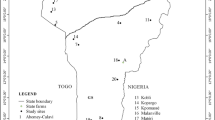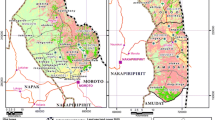Abstract
In the Indian Himalayan Region predominantly rural in character, livestock is one of the main sources of livelihood and integral part of the economy. Livestock mostly rely on fodder from wild. The diversity, distribution, utilization pattern, nativity, endemism, rarity, seasonality of availability, nutritive values, perceived economic values and pressure use index of livestock have not been studied. The present study attempts to enumerate 150 species of fodder representing trees (51 spp.), shrubs (54 spp.) and herbs (45 spp.). Poaceae (19 spp.) and Fabaceae (13 spp.) amongst families and Salix (6 spp.), Ficus, Clematis, and Desmodium (5 spp., each) amongst genera are rich in species. Maximum species were found in the 1801–2600 m zone, and the remaining two zones showed relatively low diversity. Out of the 150 species, 109 are used in summer, 5 winter and 36 throughout year. During rainy season, mostly grasses are used as fodder. Only 83 species are native to the Himalayan region, one species, Strobilanthus atropuroureus is endemic and 35 species are near endemic. The nutritive values of the fodder species were reviewed, and economic values and status of the species were also assessed. The pressure use index of the species was calculated on the basis of cumulative values of the utilization pattern, altitudinal distribution, availability, status, nativity and endemism. Amongst the species, Grewia oppositifoilia, Morus serrata, Indigofera heterantha, Quercus leucotrichphora, Ulmus villosa, U. wallichiana and Aesculus indica showed highest PUI indicating high preference and pressure. Season wise prioritization of the species for different altitudinal zones has been done. Appropriate strategy and action plan have been suggested for the conservation and management of fodder species.
Similar content being viewed by others
References
Anonymous. 1883–1970. Index Kewensis Plantarum Phanerogamarum Vol.1–2 (1883–1885) and 15 Suppl. (1886–1970) (Oxford: Clarendron Press).
Anonymous. 1970–1997. Wealth of India. A dictionary of Indian raw materials and industrial product. Vol. A–Z. Council of Scientific Industrial Research, New Delhi.
Aswal, B.S. and Mehrotra, B.N. 1987. Ethnobotanical studies on the flora of Lahaul valley (North-West Himalaya). In: Sharma, M.R. and Gupta, B.K. (eds.), Recent advances in plant sciences. Bishen Singh and Mahendra Pal Singh, Dehradun. pp. 116–130.
Aswal B.S. and Mehrotra B.N. 1994. Flora of Lahaul-Spiti. (A Cold Desert in North-West Himalayas). Bishen Singh Mahendra Pal Singh, Dehradun.
Badola H. K. and Aitken S. 2003. The Himalayas of India: A treasure of medicinal plants under siege. Biod. 4(3): 3–13.
Balaraman N. 1981. Feeds and fodder resources for livestock in Sikkim. Research Bill No.13 ICAR Research complex for NEH Region, Sikkim centre, Gangtok.
Bisht J.K., Chandra S., Mani V.P. and Singh R.D. 1999. Fodder production and management strategies for hills. VPKS-ICAR; Almora
Chauhan N.S. 1999. Medicinal and Aromatic Plants of Himachal Pradesh. Indus Publishing Company, New Delhi.
Chowdhery H.J. and Wadhwa B.M. 1984. Flora of Himachal Pradesh, Vols. 1–3. Botanical Survey of India, Culcutta.
Collett H. 1902. Flora Simlensis. Thacker Spink. & Co Calcutta and Shimla, Reprinted 1971. Bishen Singh Mahendra Pal Singh, Dehradun.
Dhaliwal D.S. and Sharma M. 1999. Flora of Kullu District (Himachal Pradesh). Bishen Singh Mahendra Pal Singh, Dehradun.
Dhar U. and Samant, S.S. 1993. Endemic diversity of Indian Himalaya. I. Ranunculaceae and II. Paeoniaceae. Journal of Biogeography 20: 659–668.
Gutteridge R.C., 1995. The potential of nitrogen fixing trees in livestock production systems. Paper presented in International Workshop on Nitrogen Fixing Trees for Fodder held in Pune, India, March 20–25, 1995.
Koelz W. N. 1979. Notes on Ethnobotany on Lahaul, a province of Punjab. Quarterly Journal of Crude Drug Research 17: 1–56.
Misri B. 1998. Proceeding of Third Temperate Asia Pasture and Fodder Network (TAPAFON). FAO, Rome.
Mohan N.P. and Puri, G.S. 1955. The Himalayan conifers. Vol. III. The succession of forest communities in oak conifer forest of the Bashahr Himalaya. Indian Forester 81(8): 711p
Purohit K. and Samant S.S. 1995. Fodder trees and shrubs of Central Himalaya. Gyanodaya Prakashan, Nainital.
Pandey K. K. 1982. Fodder trees and Tree fodder in Nepal Swiss Development and Corporation, Berne, Switerzerland.
Samant S.S. 1998. Diversity, distribution and conservation of fodder resource of west Himalaya, India. In: B. Misri (ed.), Proceedings of the Third Temperate Pasture and Fodder Network (TAPAFON), Pokhra, Nepal, 9–13 March, 1998, sponsored by F.A.O., Rome. pp. 109–128.
Samant S.S. and Dhar U. 1997. Diversity, endemism and economic potential of wild edible plants of Indian Himalaya. International Journal of Sustainable Development and World Ecology 4: 179–191.
Samant S.S., Dhar U. and Palni L.M.S. 1998. Medicinal Plants of Indian Himalaya: Diversity Distribution Potential Values. Gyanodaya Prakashan, Nainital.
Samant S.S., Rawal R.S. and Dhar U. 2006. Diversity, extraction, and status of fodder species in Askot Wildlife Sanctuary, West Himalaya, India. International Journal of Biodiversity Science and Management (2): 29–42.
Sharma M. and Dhaliwal D.S. 1997. Additions to the Flora of Himachal Pradesh from Kullu District. Journal of Bombay Natural History Society 94(2): 447–450.
Sharma, M. and Singh, H. 1996. Phytogeographic observations on the Flora of Chamba District (Himachal Pradesh) Part-II. New Botanist 23: 103–112.
Singh D.K. and Hajra P.K. 1997. Floristic diversity. In Changing Perspectives of Biodiversity Status in the Himalaya (ed. Gujral, G. S. and Sharma, V.) British Council Division, British High Commission, New Delhi. pp. 23–38.
Singh J.S., Singh S.P. and Jeet Ram 1998. Fodder and Fuel wood resources of central Himalaya. Problems and Solutions. Report Submitted for Study Group on Fuel and Fodder, Planning Commission, Government of India, New Delhi.
Singh S.K. and Rawat G.S. 2000. Flora of Great Himalayan National Park. Bishen Singh Mahendra Pal Singh, Dehradun.
Ved D.K., Kinhal G.A., Ravikumar K., Prabhakasan V., Ghate U., Vijaya Shankar R. and Indresha J.H. 2003. Conservation assessment and management prioritisation for medicinal plants of Jammu and Kashmir, Himachal Pradesh and Uttaranchal. Foundation for Revitalisation of Local Health Traditions, Banglore.
Author information
Authors and Affiliations
Corresponding author
Rights and permissions
About this article
Cite this article
Samant, S.S., Singh, M., Lal, M. et al. Diversity, distribution and prioritization of fodder species for conservation in Kullu District, Northwestern Himalaya, India. J. Mt. Sci. 4, 259–274 (2007). https://doi.org/10.1007/s11629-007-0259-1
Received:
Accepted:
Issue Date:
DOI: https://doi.org/10.1007/s11629-007-0259-1




